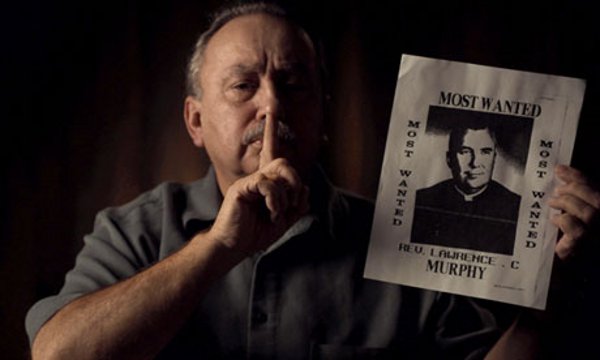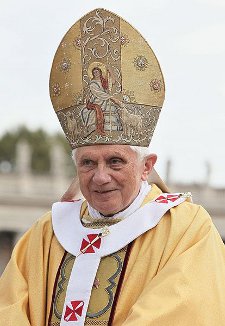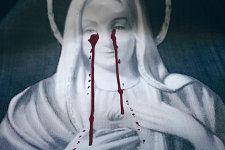
Taxi To The Dark Side director Alex Gibney's new documentary Mea Maxima Culpa found itself arriving onto UK screens in the same week in February 2013 as Pope Benedict XVI announced his departure. Given that Gibney's documentary traces the sordid history of sexual abuse and cover up in the Catholic Church and how this pathology of secrecy and denial extends far up the ranks of the Vatican, the coincidence is eerie and one the filmmaker has been quick to comment on in recent interviews.
Gibney's film examines the case of five deaf men who were abused as boys by one priest at the St John's School for the Deaf, in Milwaukee, during the 1960s. Neither the authorities nor the Vatican seemed willing to help them. Gibney's film expands beyond this one case to look at the wider issue of how the Vatican deals with (or fails to deal with) these crimes. Benedict XVI does not escape the spotlight, as the documentary analyses how, in his earlier capacity as Cardinal Ratzinger, he was responsible for ordering all reports of sex abuse to be channelled through his office at the Congregation of the Doctrine of Faith, which he ran from 2001 to 2005.
In this interview, conducted at the London Film Festival where his film was shown, Gibney explains the background to his documentary and what he thinks the flood of revelations means for the Catholic Church -and the Pope-in the years to come.
Interviewer: What's been the Vatican's response to your film?
AG: Nothing, no response, silence. Actually, when we premiered the film in Milwaukee, we did get a response from the local diocese, their response was “this is an old story, removing a scab from an old wound that probably does more harm than good.” Of course, I don't agree. Thats very typical of the church - “its all fixed now, let's move on.”
Interviewer: Did you have a practising Catholic audience in mind when putting the film together and did that influence you?

AG: It did to some extent because I was raised Catholic. I didn't want this film to be a film about religion, or about how religion is bad in some way, I wanted this to be a crime film. To essentially say to Catholics and non-Catholics that this was a crime and something needs to be done about it, and for that reason I put in a number of bits and pieces which I think deal with that issue.
Interviewer: Did you go looking for this story or did it find you, and how long was it gestating for?
AG: It found me. People I had worked with before had already said they wanted me to take it on, by that I mean the stories that were appearing front page in the New York Times. It wasn't a hidden story, so in thinking about whether to do it or not I had to consider that a lot of stories had been done about this topic. Question was, what would this film add, what I could bring to it? It seemed to me that there were good answers for that, my film was connecting a very intimate story with a very panoramic story. You follow a crime from the moment of commission to the cover up at the very top, that was very important, mixing those two ideas. The idea at the heart of it was this deaf community, which was so poignant because they were so vulnerable, but also because they fought back. They were heroic in that act of fighting back. So, it meant that this story was not just a story of victims where we wring our hands at the end - it showed that something could be done.
Interviewer: What did you get from the victims, in terms of why they wanted to tell you their stories and then pass it on to the world?
AG: I think it was the speaking out, or in this case the 'signing out', that allowed them to have their own voices heard. I think many of them were wounded precisely because they were not speaking out. It's interesting how this crime happens, they talk about a crime committed in a confessional, it's often referred to as a murder of the soul - when you are so vulnerable and exposing yourself someone who then takes advantage, that soul is being murdered. So to get that back, I think it's being able to speak out fearlessly outside of that box in public. I think that despite what that church in Milwaukee said about removing a scab, which testifies to a lack of healing, actually this process of speaking out was a kind of healing for these guys. What was burning them up inside was the idea they were having to keep this hidden.
Interviewer: Could you talk to us a little about the decisions you made about filming your deaf contributors?
AG: I was not experienced with the deaf community in any way and so I was very concerned about how to shoot them. Not just to shoot them in way that was reverential to them and their language but also because I figured most people who would ultimately see the film would be in a hearing audience. So how could I make it moving for them as well. So we did a lot of tests, and ultimately came up with a system in which we used four cameras, and also miked the subjects, which the deaf survivors were astonished about initially. But we felt that somehow hearing the sounds of them trying to communicate - whether it was the sounds of their hands clapping or their grunts and groans - would testify to the difficulty of the deaf trying to communicate with the hearing. That was important.
To do that, I had to put a teleprompter on the main camera looking directly at the interviewee, that person would be looking into the prompter, which would be showing them an image of a translator who was in another room with me. The translator would be translating for me telling me what the interviewee said, and that was how it worked. The other cameras could capture different angles. And also we did something a little unusual, we used a variable shutter, which created a kind of flutter effect in the hands so the hands themselves would be a little bit more noticeable. We felt that would be a bit more visceral.
Interviewer: Could you tell me about the stylistic choices behind the re-enactments, the film does use those in certain key places?

AG: I felt it was important to use them for these reasons. One - certain images kept coming up over and over and over for these guys. Images that were so powerful that it was almost like a kind of collective unconscious. They were memories, very vivid memories, recalled very much in the same way one would recall a scene from a horror film. And so, I filmed them very much in that style, as I thought in a way they were like a horror film. Most of the memories revolved around the dormitory, with a man creeping around at night, the idea that because you couldn't hear him coming, that was terrifying. And the red light coming off of the EXIT sign, which they all talked about.
The other thing that was important to me was that there were certain rituals, regarding both the host and the confessional, it seemed to me terribly iconic. You can talk about them all you want but for both Catholics and non-Catholics seeing the confessionals and that relationship between the priest and the confessor, and also seeing the conveying of the host, which at times has a kind of almost sexual aspect to it, all those seemed very interesting and important to visualise, so they would not be abstract but concrete. Those aren't exactly reconstructions in the sense that there is anything particular being re-imagined, they are just rituals that were felt it was important to show.
Interviewer: What was your process given the sensitivity of the subject matter?
AG: I tried to think of it almost as a “movie” movie, in particular a crime film. At times, it was a horror film. Very often in horror films you'll see scenes of the innocent before the monster comes and breaches that innocence in some horrible way. The music very much was composed with that in mind,sometimes like a classic Hitchcock thriller in some ways, sometimes with that “innocence threatened by something round the corner” vibe in mind. All these things were very much in my mind when thinking about the imagery in the film.
You know a big influence in my working life has been the spanish filmmaker Luis Buñuel. Watching his film Exterminating Angel is what got me into wanting to as a filmmaker to begin with.
So, I suppose in that way there might have been some kind of surrealist sensibility to my work. Some of these choices for me are very intuitive. But one of the great things about surrealists is that they take real material, material that feels real, and by juxtaposition, they can make it feel odd. It was very important for me to start this film with a sense of innocence. I asked all the survivors what they loved about that school where the abuse happened, and it took some doing to convince them to talk about that. I felt it was terribly important because it was that sense of trust, affection and innocence that was violated. Unless you feel that innocence, you can't feel the violation.
Interviewer: Did you have to take any specific steps to distance yourself from the material given the emotive subject matter?
AG: Yeah. Its grim. You get angry. You get pissed off. I think the hard thing was to remember that it was not quite so simple. There were little clues here and there that reminded you that we are all human and we are not perfect. For example, we spent a lot of time discussing if we should cut out this comment that one of the interviewees made about how when he and the other boys were invited up to Father Murphy's cabin up north, they would all look at this one guy, Joe, and tease, “Hey, he should sleep with you”. That's grim, really.
They were putting him on the spot because he was weak and they were going to let him just be taken by this guy. That's not nice but its understandable given the context. Likewise, I think haunting in the background of this film is the sense that the parents failed the children. So many of them in Milwaukee couldn't communicate with their own children, or weren't suspicious enough. You can understand how these priests could take advantage of that. But still, there is that kind of frailty there. But I didn't want it to be as simple as “good boys vs bad priests”. Human interactions are a little more complicated than that. That's why we tried to find a figure such as Archbishop Leekland who is such a figure of grey.Interviewer: How did the final film differ from your initial concept?
AG: Our first cut had about 80 minutes devoted to the Milwaukee story, we found that story so rich and full of details that it was seductive. We probably could've made the film just about that. But we felt that we wanted to connect this to the story of the bigger cover-up. So the hardest problem in the cutting room was the balance between the two stories. We tried very hard to come up with a structure that would put the two together.
Interviewer: Does this film fit into a pattern with your other documentaries, you seem interested in investigating institutions and how they use and abuse power?
AG: I think that's fair. I'm clearly interested in power, how power is used and abused. This film is different in some ways in that the people affected are fighting back. But yeah thematically it does have some similarities. I think structurally it bears some similarity to Taxi To The Dark Side.
Interviewer: Are you working on other projects now?
AG: Yeah Im working on two: one is about Lance Armstrong, the other is about Wikileaks.
Interviewer: What do you want people to take away from this film, if just one thing?
AG: It's the value of everyday heroes. People speaking up really can make a difference. I find that really inspiring.
Mea Maxima Culpa: Silence In The House Of God is out at selected cinemas across the UK and Ireland now. A list of screening dates can be found at the official site.





















